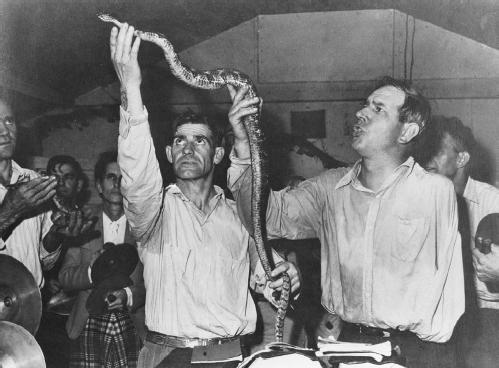SNAKE HANDLING
In the sixteenth chapter of the gospel of Mark, the resurrected Jesus (c. 6 B.C.E.–c. 30 C.E.) appears to his disciples and, before ascending to heaven, sends them forth into the world to preach the gospel. Jesus promises that all who believe in him shall cast out devils and shall speak with new tongues. In addition, believers "shall take up serpents; and if they drink any deadly thing, it shall not hurt them" (Mark 16:17–18).
In 1909, Reverend George Went Hensley (c. 1870s–1955) of the Church of God in Grasshopper, Tennessee, began to teach that those verses in Mark should be taken literally. If believers truly had the Holy Spirit within them, he argued from the pulpit, they should be able to handle rattlesnakes and any number of other venomous serpents. They should also be able to drink poison and suffer no harm whatsoever. Snake handling as a test or demonstration of faith became popular wherever Hensley traveled and preached in the small towns and backwaters of Tennessee, Kentucky, the Carolinas, Virginia, Ohio, and Indiana.
For a time, the Church of God defended the innovation of snake handling that had

Some researchers of the religious snake handling phenomenon state that the practice sprang up independently on Sand Mountain, Alabama, around 1912 without any assistance from George Hensley. Within a couple decades, snakes were being handled openly in outdoor worship services in east Birmingham. However, in 1950, the Alabama Legislature, reacting to a number of highly publicized snake fatalities, passed an act making it illegal to "display, handle, use, or exhibit any poisonous snake or reptile in such a manner as to endanger the health of another."
Those who have investigated snake handling have found that it is a popular misconception that the snakes won't bite the snake handlers in their religious ritual or that, if bitten, the handlers, under the direction of the Holy Spirit, won't die. Although exact records are difficult to substantiate, at least 71 people have been killed by poisonous snakebites during religious services in the United States. And that number includes the founder of the snake handling movement, George Went Hensley, who, it has been estimated, had been bitten over 400 times before his death in 1955. While some might consider such deaths as strong reasons to discontinue the practice of actually handling poisonous snakes during services, devout snake handlers say that it is a good thing that one of their members occasionally dies as a result of a snake bite. Such fatalities only prove to skeptics and nonbelievers that they are truly using dangerous snakes in their worship services.
In those rural churches in the Appalachian highlands where snake handling remains popular, no members of the congregations are required to handle the snakes, and in most churches, no one under the age of 18 is permitted to pick up the serpents. The American Civil Liberties Union has defended the religious freedom of snake handlers against various attempts to have the practice abolished. In Thomas Burton's Serpent-Handling Believers (1993), Burton states that snake handling is a complex traditional religious belief of a group of American Christians which should be respected for what it is.
DELVING DEEPER
Burton, Thomas. Serpent-Handling Believers. Knoxville, Tenn.: University of Tennessee Press, 1993.
Crim, Keith, gen. ed. The Perennial Dictionary of World Religions. San Francisco: HarperSanFran cisco, 1989.
Farnell, Kathie. "Snakes and Salvation." Fate, December 1996, pp. 28–32.
User Contributions:
Comment about this article, ask questions, or add new information about this topic:
Snake Handling forum
